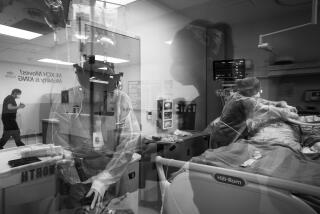Some heart patients do better when the cardiologist is away
- Share via
Holy heart attack! Researchers have found that certain high-risk heart patients stand a better chance of survival if they go to a teaching hospital when all the cardiologists have left town.
Though heart doctors have joked that the safest place to suffer a heart attack would be in a city hosting a national cardiology meeting, researchers at Harvard Medical School, USC and Santa Monica’s Rand Corp. were among a group that found the exact opposite to be true.
In research published Monday in JAMA Internal Medicine, study authors found that the survival rate for high-risk cardiac arrest patients rose 10% when they were admitted to a major teaching hospital on days that a national cardiology meetings was in session.
“That’s a tremendous reduction in mortality, better than most of the medical interventions that exist to treat these conditions,” said lead study author Dr. Anupam Jena, who teaches healthcare policy and medicine at Harvard Medical School.
High-risk heart patients are typically older people with preexisting medical conditions. They may be overweight and smoke, or suffer from diabetes or high blood pressure, among other problems.
It remains unclear exactly why this subset of patients experienced substantially lower mortality rates while low-risk patients did not. Also, researchers did not find the same disparity in survival rates at nonteaching hospitals.
The answer, however, might have to do with the reluctance non-cadiologist doctors have in performing aggressive or invasive procedures in the absence of a heart specialist.
In addition to the rise in survival rates, researchers found that teaching hospitals performed 7% fewer angioplasties on high-risk myocardial infarction patients during convention dates.
Researchers wrote that when treating high-risk heart patients, the answer may be that “less is more.”
“One explanation for these findings is that the intensity of care provided during meeting dates is lower and that for high-risk patients with cardiovascular disease, the harms of this care may unexpectedly outweigh the benefits,” authors wrote.
The study examined the 30-day mortality rate for 8,570 Medicare beneficiaries who were hospitalized for acute myocardial infarction, heart failure or cardiac arrest on national cardiology meeting dates from 2002 to 2011.
Those rates were then compared to 57,471 similar patients who were admitted three weeks before and after meeting dates.
The results were the exact opposite of what researchers had anticipated.
Only 17% of high-risk heart failure patients died on meeting dates, but almost 25% died on non-meeting dates. The gap was even wider for high-risk cardiac arrest patients: 59% died on meeting days, 69% on non-meeting days.
The researchers had hypothesized incorrectly that mortality rates would rise on meeting dates and that this rise would be particularly noticeable at teaching hospitals, where cardiologists were more likely to attend national meetings.
In an accompanying note, journal editor and UC San Francisco cardiologist Dr. Rita Redberg said it was a relief to know that patient outcomes do not suffer when cardiologists were away at meetings.
However, it was still unclear how the findings should be interpreted.
“One possibility is that more interventions in high-risk patients with heart failure and cardiac arrest leads to high mortality,” Redberg wrote.
“Indeed, some high-risk interventions, such as balloon pumps or ventricular assist devices, are being used in populations in which they are not shown to improve outcomes, and recent reports have raised concerns about high rates of fatal complications from pump thrombosis and other problems,” Redberg wrote.
The authors of the study said theirs was not the first to find an unexpected connection between mortality rates and the absence of physicians.
“Our results echo paradoxical findings documented during a labor strike by Israeli physicians in 2000, in which hundreds of thousands of outpatient visits and elective surgical procedures were canceled, but by many accounts mortality rates dramatically fell during the year,” authors wrote.
Follow @montemorin for science news







